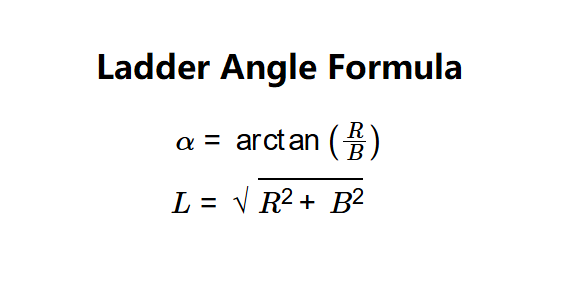1. What is the Ladder Angle Calculator?
Definition: This calculator determines the angle of a ladder (α) and its working length (L) based on the ladder reach (R) and the distance from the wall or structure (B).
Purpose: It helps construction workers, DIY enthusiasts, and safety inspectors ensure that a ladder is positioned at a safe angle (typically around 75.5° for a 4:1 ratio) and to determine the required ladder length for safe climbing.
2. How Does the Calculator Work?
The calculator uses the following equations:
- Ladder Angle: \( \alpha = \arctan\left(\frac{R}{B}\right) \)
- Ladder Working Length: \( L = \sqrt{R^2 + B^2} \)
Where:
- \( \alpha \): Ladder angle in degrees (°);
- \( R \): Ladder reach, the vertical height to climb (cm, m, in, ft, or yd);
- \( B \): Distance between the ladder bottom and the wall/structure (cm, m, in, ft, or yd);
- \( L \): Ladder working length, the hypotenuse of the right triangle formed (cm, m, in, ft, or yd).
Steps:
- Enter the ladder reach (R) and select its unit (cm, m, in, ft, or yd).
- Enter the distance from the wall (B) and select its unit (cm, m, in, ft, or yd).
- Convert inputs to meters for calculations.
- Calculate the ladder angle using \( \alpha = \arctan(R/B) \), converted to degrees.
- Calculate the ladder working length using \( L = \sqrt{R^2 + B^2} \).
- Convert the length result to the selected output unit (cm, m, in, ft, or yd).
- Display results, formatted in scientific notation if the absolute value is less than 0.001, otherwise with 4 decimal places.
3. Importance of Ladder Angle Calculation
Calculating the correct ladder angle and length is crucial for:
- Safety: Ensures the ladder is positioned at a safe angle (e.g., 75.5° for a 4:1 ratio) to prevent tipping or slipping.
- Proper Equipment Selection: Determines if the ladder’s length is sufficient for the required reach.
- Compliance: Meets occupational safety standards, such as OSHA’s recommendation for ladder positioning.
- Efficiency: Avoids trial-and-error setup, saving time and effort on construction sites.
4. Using the Calculator
Example 1 (Metric Units): Calculate the ladder angle and length with mixed units:
- Ladder Reach: \( R = 400 \, \text{cm} = 4 \, \text{m} \);
- Distance from Wall: \( B = 1 \, \text{m} \);
- Output Unit: Meters;
- Ladder Angle: \( \alpha = \arctan\left(\frac{4}{1}\right) \approx 75.9638^\circ \);
- Ladder Working Length: \( L = \sqrt{4^2 + 1^2} = \sqrt{17} \approx 4.1231 \, \text{m} \);
- Result: \( \alpha = 75.9638^\circ \), \( L = 4.1231 \, \text{m} \).
Example 2 (Imperial Units): Calculate the ladder angle and length with imperial units:
- Ladder Reach: \( R = 16 \, \text{ft} \);
- Distance from Wall: \( B = 1.3333 \, \text{yd} \approx 4 \, \text{ft} \);
- Output Unit: Feet;
- Ladder Angle: \( \alpha = \arctan\left(\frac{16}{4}\right) \approx 75.9638^\circ \);
- Ladder Working Length: \( L = \sqrt{16^2 + 4^2} = \sqrt{272} \approx 16.4924 \, \text{ft} \);
- Result: \( \alpha = 75.9638^\circ \), \( L = 16.4924 \, \text{ft} \).
5. Frequently Asked Questions (FAQ)
Q: What is the ideal ladder angle?
A: The ideal ladder angle is approximately 75.5°, corresponding to a 4:1 ratio (4 units of reach for 1 unit of distance from the wall).
Q: Does this calculator account for ladder weight or material?
A: No, it calculates based solely on reach and distance. Weight or material considerations may require additional safety checks.
Q: Can I use this for extension ladders?
A: Yes, as long as you input the reach and distance for the ladder’s working position, the calculator applies to any ladder type.
Ladder Angle Calculator© - All Rights Reserved 2025
 Home
Home
 Back
Back
